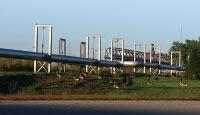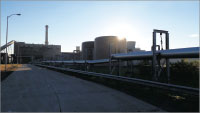A General Motors assembly plant is getting closer to achieving its renewable energy and waste diversion goals by taking advantage of its proximity to Detroit’s waste-to-energy facility.
 General Motors (GM) is making progress toward its aggressive sustainability goals in 2014. The Detroit-based automaker has reported that it plans to use some 125 megawatts of renewable energy annually within its energy portfolio by 2020.
General Motors (GM) is making progress toward its aggressive sustainability goals in 2014. The Detroit-based automaker has reported that it plans to use some 125 megawatts of renewable energy annually within its energy portfolio by 2020.
As of 2014, about 16 megawatts of that amount, or about 12 percent, is being generated at one GM facility: the Hamtramck, Michigan, assembly plant where GM makes the Chevrolet Volt, Malibu and Impala vehicles.
In July 2014 the company began benefitting from a project in which piped steam from the nearby waste-to-energy (WTE) plant, owned by Detroit Renewable Power (DRP), is being used to power heating and cooling systems in the GM plant as well as for some process operations. This energy, produced from renewable municipal solid waste (MSW), is providing GM a significant reduction in greenhouse gas emissions since the facility no longer has to burn coal.
With this latest project, the Hamtramck facility has become a top GM site in terms of corporate sustainability efforts. Already sending most of its nonrecyclable byproducts to the WTE facility, it is contributing toward capital investment savings and continued progress toward achieving landfill-free status.
Top performer
The 3.6-million-square-foot Hamtramck facility opened in 1985. At 1,619 employees, it is among the largest of GM’s North American facilities. By virtue of its new steam pipeline, GM also says this plant is its first to employ WTE processes directly to power operations, and it is the automaker’s top facility in the world by percentage of renewable energy used, according to Rob Threlkeld, global manager of renewable energy for GM.
Threlkeld says with this project, an estimated 58 percent of the plant’s annual energy needs will be met by the steam that is being piped over to the plant via a new 8,000-foot pipeline from the DRP WTE facility, located about a mile to the southwest. Construction of the $12 million pipeline began in late 2013, and the system went online in July 2014.
The decision to install the pipeline involved collaboration between Detroit Renewable Energy (DRE) and its subsidiaries DRP (the city’s WTE facility) and Detroit Thermal (the utility that owns and services a central district steam network serving 140 downtown Detroit buildings via 39 miles of pipelines under the city).
Located just north of DRP and the downtown steam loop, Hamtramck is benefitting from its proximity to the pipeline and from Detroit Thermal’s expertise in piping steam.
“It made sense to explore this option with Detroit Renewable Energy at Detroit Hamtramck, given their quality work in helping us manage our energy use at some of our other GM plants,” Threlkeld says. GM has contracted with DRE to operate and staff the powerhouse at its Hamtramck facility for several years, as well as other GM powerhouses in Michigan, Texas and Kansas.
In addition, several GM facilities in the region have sent their nonrecyclable byproducts to DRP for nearly a decade, says John Bradburn, manager of waste reduction for GM. Bradburn says GM adheres to a strict resource efficiency policy which includes the use of WTE.
“We have around 2.2 million tons a year of byproducts that we generate,” says Bradburn. “Our pollution prevention hierarchy is to eliminate, reuse, recycle and compost, in that order. If those options are not there, the byproducts will go to an energy option if it’s available.”
Bradburn estimates about 4 percent of GM’s manufacturing scrap globally goes to energy options, which ends up being a significant amount of material. Ten GM plants in the greater Detroit region are now sending the high-British-thermal-unit (Btu) byproducts that can’t be recycled, reused or composted to DRP.
“We have very good cardboard and plastic recycling programs,” Bradburn points out, noting that any waste delivered to DRP should have minimal amounts of those materials. Landfilling is GM’s least desired option for waste, he adds.
Power partner
DRE played an integral role in GM’s ability to use the steam line to meet the majority of its energy needs. Before it was installed, the Hamtramck plant generated its own steam using two coal-fired boilers. However, Threlkeld says, tighter emissions standards expected for 2015 would have required significant capital expenditures to retrofit the boilers.
“They were looking at the option of converting the plant to natural gas,” recalls David Beavens, chief operating officer of DRE. “Because we were already producing steam for the district network, and we were within 8,000 feet of the facility, we came up with the idea of piping steam over to them,” he adds.
Threlkeld says it proved to be more cost-effective for GM to invest in the steam DRE was piping than to retrofit the plant’s coal-fired boilers, which have since been shut down. Now, the pipeline is supplying all of the facility’s steam needs.
The 15-year contract with DRE allowed GM to avoid around $6 million in capital investments as well as ongoing savings associated with having to produce its own steam. “This seemed to work hand-in-hand from a financial point of view,” Threlkeld says. “It provided steam for our use and allowed us to avoid the capital investment of having to retrofit our two coal-fired boilers.”
 The equipment in the powerhouse — the three 4,000-ton turbine-driven chillers and one air compressor unit—are driven by steam. Use of the pipeline steam also has allowed GM to curtail its use of coal at the only remaining GM facility in North American that burned it.
The equipment in the powerhouse — the three 4,000-ton turbine-driven chillers and one air compressor unit—are driven by steam. Use of the pipeline steam also has allowed GM to curtail its use of coal at the only remaining GM facility in North American that burned it.
Bradburn says the steam pipeline also yields a significant decrease in both greenhouse gas emissions and in landfilled materials. The incorporation of steam from DRP will reduce plant-reported carbon emissions from the previous level of 76,157 metric tons per year to an estimated 18,778 metric tons, according to GM. Furthermore, GM no longer has to landfill coal ash from the coal-fired boilers, which Bradburn says was a challenging material to find options for. “It was a significant stream that we wanted to eliminate,” he says.
While Hamtramck is not one of the 111 GM facilities that have achieved landfill-free status so far, Bradburn says its elimination of coal ash is an important step in that direction. “This improves the facility’s options when looking at landfill-free, because coal ash was a significant component of our waste,” says Bradburn (He recognizes, however, that DRP’s combustion process does generate bottom ash that is landfilled.)
Waste-to-energy process
DRP burns refuse-derived fuel (RDF) created from municipal solid waste (MSW), as it has done for more than 20 years. (The plant was formerly owned by Covanta).
According to David Beavens, chief operating officer of DRE, the plant receives 3,500 tons of MSW per day, primarily from the greater Detroit area. The MSW is processed into RDF which DRP uses to fuel its boilers. Beavens says the resulting steam is piped to Hamtramck and through its district steam network. A third portion of the steam is allocated to a turbine generator for production of electricity that is sold to Detroit Edison for the local power grid. Beavens says the RDF combustion process can supply all three of these processes during normal demand loads.
“We run two boilers at a time, with a set point of 335,000 pounds an hour of steam per boiler,” Beavens says. “That’s enough steam during normal times to meet the needs of Detroit Thermal and General Motors, with the residual used to generate electricity.” He adds that in times of peak demand, the generation side is adjusted downward or eliminated.
DRP’s facility is equipped with three boilers, one 75-megawatt turbine and three fuel processing lines each rated at 45 tons per hour. The facility also includes a tipping floor for MSW, scale house and RDF storage area. Metal recovery occurs on the front end, via manual sorting, and then again postcombustion, using a screening and magnet process.
Beavens says the facility generates about 5.3 million pounds of steam annually from the more than 900,000 tons of MSW processed each year. About 10 percent of that steam is allocated to GM’s Hamtramck facility.
The 20-inch diameter pipeline to Hamtramck runs both below and above ground on a circuitous path below Interstate 94 and up to Hamtramck, where it narrows to a 16-inch line upon reaching the powerhouse. A condensate return line allows water to be reused.
Threlkeld says the steam is used for comfort heating in the winter by way of a heat exchanger in the powerhouse to heat a central closed-loop system, which provides hot water to the plant. In the summer months, the plant uses steam-driven chillers to produce chilled water to cool the same system. Some steam also is used in the paint shop for humidification, while another portion powers an air compressor unit.
The $12-million steam line project was funded through a bond issue by Detroit Thermal, the regulated utility that owns the district network.
“It took us two years to get through the course of making the process work and creating a contract that everyone could live with,” says Rick Pucak, president of Detroit Thermal. “I think it turned out to be a win-win both for us and for them.”
He also says Hamtramck requires between 400,000 and 450,000 pounds per year of steam, making it one of DRP’s largest customers, “if not the largest.” Pucak references the GM Renaissance Center, the international headquarters complex downtown which is connected to the district steam network and requires only half as much steam.
Future plans
With the Hamtramck pipe online, Threlkeld says the company will continue to make progress towards its 125-megawatt renewable energy goal with two more projects nearing completion in 2014. The company is close to completing two landfill gas projects at GM facilities in Fort Wayne, Indiana, and Orion, Michigan, that will generate a combined 14 MW of electricity.
Threlkeld says once those projects are up and running, GM will be on track to produce around 100 megawatts of renewable energy per year, which is more than 75 percent of the way to its 2020 goal. Those projects also will deliver additional reductions in greenhouse gas emissions, as well as some $10 million in saved energy costs, he says.
GM also is using solar energy and a small amount of hydroelectric power within its renewable energy portfolio, Threlkeld says. However, he indicates that the use of WTE will remain a key sustainability strategy for the company going forward.
Heading into 2015, Threlkeld says the energy mix at GM may change as new projects are announced. While he isn’t ready to disclose details, he emphasizes WTE will remain front and center. “Landfill gas and waste-to-energy will still be the largest components of that 125-megawatt goal,” he says.
The author is a managing editor with the Recycling Today Media Group, publisher of Renewable Energy from Waste magazine.